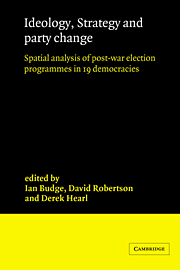 Ideology, Strategy and Party Change
Ideology, Strategy and Party Change Book contents
- Frontmatter
- Contents
- List of Tables
- List of Figures
- Preface
- 1 The influence of election programmes: Britain and Canada 1945–1979.
- 2 The internal analysis of election programmes.
- 3 Britain, Australia, New Zealand and the United States 1946–1981, an initial comparative analysis.
- 4 Canada 1945–1980: party platforms and campaign strategies.
- 5 Sri Lanka 1947–1977: elite programmes and mass politics.
- 6 Israel 1949–1981.
- 7 Ireland 1948–1981: issues, parties, strategies.
- 8 Northern Ireland 1921–1973: party manifestos and platforms.
- 9 Sweden and Denmark 1945–1982: election programmes in the Scandinavian setting.
- 10 The Netherlands 1946–1981.
- 11 Belgium 1946–1981.
- 12 Luxembourg 1945–1982: dimensions and strategies.
- 13 Austria 1945–1978.
- 14 Electoral programmes in West Germany 1949–1980: explorations in the nature of political controversy.
- 15 France 1958–1981: the strategy of joint government platforms.
- 16 Italy 1946–1979: ideological distances and party movements.
- 17 Japan 1960–1980: party programmes in elections.
- 18 Do parties differ, and how? Comparative discriminant and factor analyses.
- Appendices
- General bibliography
- Index
10 - The Netherlands 1946–1981.
Published online by Cambridge University Press: 27 October 2009
- Frontmatter
- Contents
- List of Tables
- List of Figures
- Preface
- 1 The influence of election programmes: Britain and Canada 1945–1979.
- 2 The internal analysis of election programmes.
- 3 Britain, Australia, New Zealand and the United States 1946–1981, an initial comparative analysis.
- 4 Canada 1945–1980: party platforms and campaign strategies.
- 5 Sri Lanka 1947–1977: elite programmes and mass politics.
- 6 Israel 1949–1981.
- 7 Ireland 1948–1981: issues, parties, strategies.
- 8 Northern Ireland 1921–1973: party manifestos and platforms.
- 9 Sweden and Denmark 1945–1982: election programmes in the Scandinavian setting.
- 10 The Netherlands 1946–1981.
- 11 Belgium 1946–1981.
- 12 Luxembourg 1945–1982: dimensions and strategies.
- 13 Austria 1945–1978.
- 14 Electoral programmes in West Germany 1949–1980: explorations in the nature of political controversy.
- 15 France 1958–1981: the strategy of joint government platforms.
- 16 Italy 1946–1979: ideological distances and party movements.
- 17 Japan 1960–1980: party programmes in elections.
- 18 Do parties differ, and how? Comparative discriminant and factor analyses.
- Appendices
- General bibliography
- Index
Summary
INTRODUCTION
The literature on Dutch party manifestos is sparse (Lipschits 1977, 1981; De Bruyn 1971). In this chapter we make a first attempt to compare them systematically, as distinct from analysing them impressionistically (De Bruyn 1971) or using them in an ad hoc manner – for example, to provide a basis for ordering the political parties of the Netherlands on a left–right dimension (Lipschits 1969; De Swaan 1973). Only one author has used methods similar to ours, contrasting the 1948 and 1963 election manifestos of the KVP, PvdA, VVD and ARP to see whether the parties have become more alike (Hoogerwerf 1963, 1964, 1965).
There are a number of reasons for this apparent lack of interest. In the first place it is difficult to make a distinction between election manifestos and other manifestos or platforms. Hoogerwerf argued; ‘In the Netherlands a distinction is made between a party's election programme (listing among other things its objectives for a four-year parliamentary period), its constitution (containing the main principles of the party), its general political programme (its objectives for a period longer than four years), its provincial programme and its municipal programme’ (Hoogerwerf 1964, p. 163). This may be so, but it is far from easy to distinguish clearly. All political parties have constitutions, and these are mentioned as such, but the line between election programmes and general political programmes has not always been clear. Moreover, some of the programmes are cited as ‘urgency programmes’.
- Type
- Chapter
- Information
- Ideology, Strategy and Party ChangeSpatial Analyses of Post-War Election Programmes in 19 Democracies, pp. 207 - 229Publisher: Cambridge University PressPrint publication year: 1987
- 2
- Cited by


